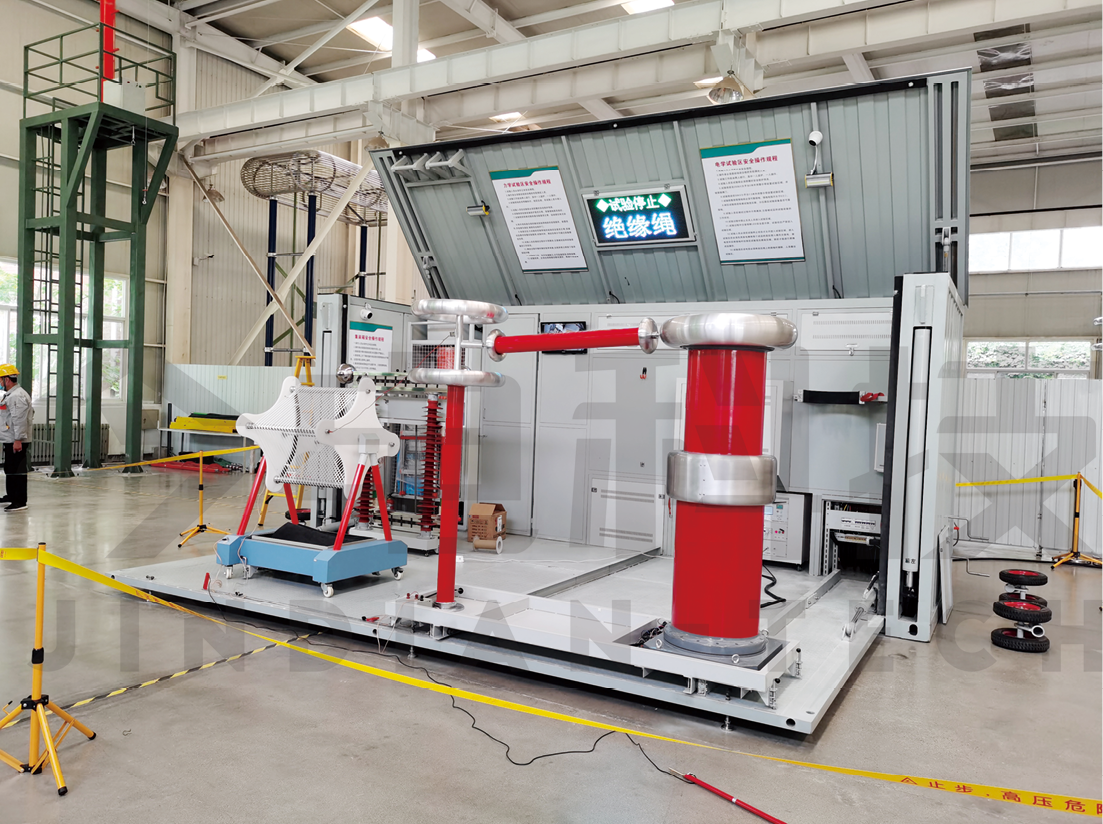Product
JD1100 series safety tool and equipment container testing platform
Regular preventive testing of safety tools and equipment is a safety guarantee for daily operations of power workers. Safety protective equipment is widely used and stored in dispersed locations. Although safety tool and equipment testing centers for live-line work have been established in various provinces and cities, they can only partially meet the testing requirements for live-line work equipment. However, the method of submitting equipment for testing through various units is inefficient and time-consuming, causing inconvenience to the use and management of live-line work equipment at the grassroots level. Currently, specialized testing vehicles are used for on-site testing. While this method is convenient and allows for immediate deployment, it suffers from low operational efficiency due to long periods of idle time and requires a professional driver. The procurement of additional motor vehicles is also subject to strict approval processes. Therefore, using a standard containerized mobile testing laboratory can solve these problems and eliminate the need for vehicle registration, annual inspections, etc., for specialized motor vehicles. Patrol inspections typically involve fixed-point testing, where testing is conducted at one location before moving to the next. The "Safety Tool and Equipment Container Testing Platform" is well-suited to this work model. The application of the safety tool and equipment container testing platform eliminates the need for civil engineering for a testing laboratory; only a vacant space is needed for storage and testing, significantly reducing construction costs. This method not only greatly improves work efficiency and reduces the burden on grassroots workers but also allows for on-site training of live-line work equipment users through patrol inspections.
Category:
Email:
Messages
Product description
Regular preventive testing of safety tools and equipment is a safety guarantee for daily operations of power workers. Safety protective equipment is widely used and stored in dispersed locations. Although safety tool and equipment testing centers for live-line work have been established in various provinces and cities, they can only partially meet the testing requirements for live-line work equipment. However, the method of submitting equipment for testing by each unit is inefficient and time-consuming, causing inconvenience to the use and management of live-line work equipment at the grassroots level.
The current method uses special testing vehicles for on-site testing. While convenient and readily deployable, this method suffers from low operational efficiency due to prolonged vehicle idling and requires a professional driver. Furthermore, the procurement of additional motor vehicles faces strict approval processes. Therefore, using a standard containerized mobile testing laboratory can solve these problems and eliminate the need for vehicle registration, annual inspections, and other issues associated with special motor vehicles.
Patrol inspections typically involve fixed-point testing, moving to the next testing point after a period of testing. The "Safety Tool and Equipment Container Testing Platform" is well-suited to this work model.
The application of the safety tool and equipment container testing platform eliminates the need for civil engineering for a testing laboratory; only a vacant space is needed for storage and testing, significantly reducing infrastructure costs. This method not only significantly improves work efficiency and reduces the burden on grassroots personnel but also allows for on-site training of live-line work equipment users through patrol inspections.
- The safety tool and equipment container testing platform uses a 20-foot container as a carrier for testing equipment, installing electrical and mechanical testing equipment onto a specially designed container to form a complete safety tool and equipment testing system.
- The testing platform has an auxiliary hydraulic loading and unloading system. The container can be lifted using a hydraulic device, a flatbed vehicle can drive under the container, and the container can then be lowered for loading.
- The testing platform is equipped with casters and a vertical hydraulic cylinder, allowing for manual short-distance movement for easy positioning and loading.
- The testing platform is divided into three spaces by a central partition. The right side wall of the container unfolds downwards, creating a large space that serves as a high-voltage testing platform, primarily for testing 110kV and below insulators, voltage testers, and insulated ropes.
- When the left side door of the container is opened, the interior houses a comprehensive mechanical testing device, forming a mechanical testing area.
- When the left side window is opened downwards, it forms a work platform serving as a medium-voltage work platform. It is equipped with a 50kV testing device, primarily for testing insulating boots, insulating suits, insulating mats, and shielding hoods.
- These three work stations can conduct tests simultaneously, significantly improving work efficiency and reducing operating costs compared to a single workstation in a testing vehicle.
- The testing platform is equipped with a complete safety protection system, including a large LED display showing testing items and operating status, a wireless safety protection system, and fences, forming a comprehensive safety protection system.
- All three testing spaces are equipped with lighting for nighttime testing.
- The high-voltage and medium-voltage testing systems are equipped with wireless testing consoles, allowing for remote operation away from the high-voltage testing area. The testing consoles have complete operational prompts and standard query functions, and the testing system can automatically determine whether the tested items are qualified.
- The safety tool and equipment container testing platform can also be configured with a cloud platform management system, connecting the three workstation testing systems and the group resistance tester directly to the cloud platform. Items can be scanned for identification, retrieving archival data, and uploading test data to the cloud platform during testing, enabling remote data review, approval, and report generation.

- Insulating Boots Withstand Voltage and Leakage Current Test (10~35kV)
- Insulating Gloves Withstand Voltage and Leakage Current Test (10~35kV)
- Insulating Rods Withstand Voltage Test (10~110kV)
- Voltage Testers Withstand Voltage Test (10~110kV)
- Voltage Testers Starting Voltage Measurement (10~110kV)
- Insulated Ropes Withstand Voltage Test
- Insulating Mats, Insulating Panels, Insulating Clamps Withstand Voltage Test
- Insulating Clothing, Insulating Blankets Withstand Voltage Test
- Shielding Hoods Withstand Voltage Test
- Safety Hooks, Safety Belts, Ladders, Lanyards, Insulating Ladders Mechanical Test
- Personal Safety Lines, Portable Short-Circuit Grounding Lines Resistance Measurement and Withstand Voltage Test
|
Rated Output Voltage |
250kV |
Leakage Current Resolution |
0.01mA |
|
Rated Capacity |
25kVA |
Mechanical Test Range |
20kN |
|
Power Supply Voltage |
Three-phase four-wire 380V 50Hz |
Container External Dimensions |
5690*2050*2510(mm) |
|
Voltage Measurement Error |
1.0% reading + 0.1% range |
Container Total Weight |
5800kg |
|
Current Measurement Error |
0.5% reading + 0.05% range |
Wireless Control Console Dimensions |
700*500*960(mm) |
|
Leakage Current Range |
25mA |
Folded Dimensions |
700*500*170(mm) |
|
Leakage current error |
1.0% reading + 0.1% range |
|
|
Previous page
Recommended products
SAUNDERS
If you have any suggestions or feedback on our company, please fill in the relevant information on this page and submit it. A staff member will contact you in time, or please call us directly.








